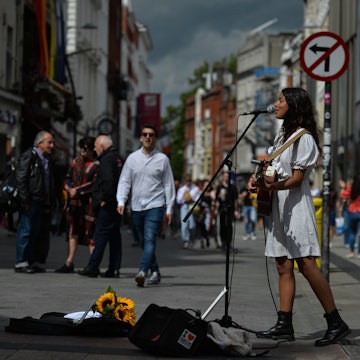

Many visitors choose to rent a car, but with a bit of patience you can also get around Miami using public transportation © Dmitro2009 / iStock Editorial / Getty Images Plus
Miami's major sights aren't concentrated in one area, which means that any trip to the city will involve jumping from one sprawling neighborhood to another. So whether it's a car, bus or the Metrorail, your best bet for exploring is by using a set of wheels.
One of the most frequently visited areas is Miami Beach, home to some of South Florida's hottest nightlife, beaches and its most iconic art deco hotels. But cross the causeway into Miami, and you'll find historic sites and museums in the Downtown area, street art in Wynwood, luxury shopping in the Design District and peaceful neighborhood attractions in Coral Gables and Coconut Grove.
Connecting it all are fast highways, buses and the Metrorail (along with its little sister, the Metromover). Give some thought to renting a car or opting for a rideshare app – it's the easiest way to reach many parts of the city quickly and efficiently. (Besides, the humidity and heat can make walking a seriously sweaty business during most of the year.)
You can explore the most neighborhoods by car
There's no doubt about it – the most straightforward way to see Miami is by car. While it may not have the population of New York City or Chicago, there's a considerable amount of urban sprawl that makes it impossible to traverse the city on foot. And while there are a few public transportation options available, some are very limited in the geography they cover, while others can be unreliable on the best of days.
Plus, if you want to jump between Miami Beach and Miami, you're going to have to cross one of four causeways (the MacArthur, the Venetian, the Julia Tuttle or the John F Kennedy) and going by car is the easiest way to do that.
Save our top neighborhood picks in Miami

Understanding Miami's roads
Miami is fairly easy to navigate as it's laid out in a logical north-to-south and east-to-west grid marked by ascending and descending numbers. Street addresses are essentially like finding a point on a Cartesian plane ("the restaurant is on the corner of 8th St and 14th Ave"), so once you've gotten your bearings, finding most things is relatively simple.
Traversing the city are major expressways – the Dolphin/836, the Palmetto/826, the I-95, and the Florida Turnpike are some of the major ones to take note of. The tolls for these roads are automated, so ask about options to include tolls on the SunPass scheme in the rental cost if you're renting a vehicle. You can find great deals on car rental in Miami, with rates starting as low as $30 per day. The usual international hire companies are represented at the airport.
Top tips for driving in Miami
You must pay for parking nearly everywhere, and if you don't, expect no mercy from parking enforcement officials. You'll be quickly towed and will have to pay upwards of $200 plus all the associated headaches to retrieve your vehicle.
Most on-street parking is now done by a smartphone app or payment by phone, though there are still a few pay-and-display ticket machines at some locations. There are many municipal parking garages, which are usually the easiest and cheapest option – look for giant blue "P" signs.

Alternatively, leave the driving to the pros and use a rideshare
Driving around Miami isn't for the faint of heart. That's when taxis – and, even better, rideshares – come in handy. Uber, Lyft and Alto are all popular options and widely available throughout the city. Car seats for kids, wheelchair access, special assistance and pet-friendly vehicles are also available.
Another upside to rideshares is you don't have to worry about parking. Miami and Miami Beach are known for having very expensive parking lots and garages, sometimes with limited options in popular areas.
Stretch your budget by taking the bus
Miami's local bus system is called Metrobus. It can get you most places you're trying to go, but it won't get you there very quickly. Each bus route has a different schedule, and routes generally run from about 5:30am to 11pm, though some run a 24-hour service.
Rides cost $2.25 and must be paid in exact change (coins or a combination of bills and coins) or with an EASY Card (available for purchase from Metrorail stations and some shops and pharmacies). You can download a PDF of the Metrobus route map.
Top tip for taking the bus in Miami: Miami-Dade Transit uses a fare capping system, so you won't pay more than $5.65 per day for unlimited rides on Metrorail or Metrobus. The Metromover is always free (more on this below).

Travel by train to avoid traffic
The Metromover – equal parts bus, monorail and train – is helpful for getting around Downtown Miami and Brickell. It offers visitors a great perspective on the city and a free orientation tour of the area.
Metrorail is a 21-mile-long heavy-rail system that has one elevated line running from Hialeah through Downtown Miami and south to Kendall/Dadeland. Trains run every five to 15 minutes from 6am to midnight. The one-way fare is $2.25. Pay with either the reloadable EASY Card or a single-use EASY Ticket (these are sold from vending machines at Metrorail stations).
Zip around a neighborhood on a bicycle or scooter...
Miami is flat, but traffic can be horrendous (abundant and fast-moving), and there isn't much of a biking culture – or respect for bikers – just yet. Nevertheless, bikes and scooters are a popular and easy way to cruise along the beachfront or around the city.
Citi Bike is a bicycle-share program where you can borrow a bike from scores of kiosks spread around Miami and Miami Beach. There's a map of the bike network online, and some kiosks have free paper maps. There's also a handy Citi Bike app that shows you where the nearest stations are. However, bear in mind that Citi Bikes are rather clunky, so they're not ideal for longer trips. They only have three gears, and they don't come with a helmet or a lock.
A variety of scooters are also available to rent via third-party apps (Bird and Lime are popular ones) throughout Miami Beach, Downtown and Wynwood.
…or use a trolley
The City of Miami Trolley is actually a hybrid-electric bus service, using modern vehicles disguised as orange-and-green trolley buses, and it functions as a free service throughout Brickell, Coconut Grove, Little Havana, Wynwood and other neighborhoods within the City of Miami limits. There are numerous routes, though they're made for getting around neighborhoods and not between them.
The cities of Miami Beach and Coral Gables also offer their own free trolley services for getting around.

Accessible travel in Miami
Transportation services in Miami are generally accessible to all, including buses and trains, and telephone companies provide relay operators for deaf travelers. Many banks provide ATM instructions in Braille, curb ramps are common, and many busy intersections have audible crossing signals.
Miami-Dade County offers accommodations for travelers with disabilities on its beaches, in county parks and in other spaces run by the Parks, Recreation and Open Spaces Department. They advise calling ahead (305-755-7848) to reserve beach-friendly wheelchairs, which are typically available on a first-come, first-served basis. It's also advised to bring a companion as the beach chairs are not self-propelled.
There are several organizations that specialize in the needs of disabled travelers, too. They include the Great Miami Convention and Visitors Bureau, which offers accessible travel information specific to Miami and Miami Beach. Mobility International USA advises disabled travelers on mobility issues and runs an educational exchange program.
Keep planning your trip to Miami:
Add these top experiences to your itinerary
Check out these budget-friendly tips before you book
Explore beyond Miami with these day trips
















